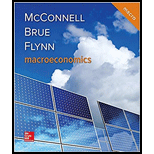
MACROECONOMICS (LL)
21st Edition
ISBN: 9781260186949
Author: McConnell
Publisher: MCG
expand_more
expand_more
format_list_bulleted
Concept explainers
Question
Chapter 4.A, Problem 1AP
(a):
To determine
Impact of asymmetric information on the price.
Sub Part b:
To determine
Impact of asymmetric information on the price.
Sub Part (c):
To determine
Impact of asymmetric information on the price.
(d):
To determine
Impact of asymmetric information on the price.
Sub Part (e):
To determine
Impact of asymmetric information on the price.
Expert Solution & Answer
Want to see the full answer?
Check out a sample textbook solution
Students have asked these similar questions
Consider a used car market with asymmetric information. The owners of used cars know what their vehicles are worth but have no way of credibly demonstrating those values to potential buyers. Thus, potential buyers must always worry that the used car they are being offered may be a low quality “lemon.” a. Suppose that there are equal numbers of good and bad used cars in the market and that good used cars are worth $13,000 while bad used cars are worth $5,000. What is the average value of a used car? b. By how much does the average value exceed the value of a bad used car? By how much does the value of a good used car exceed the average value? c. Would a potential seller of a good used car be willing to accept the average value as payment for her vehicle? d. If a buyer negotiates with a seller to purchase the seller’s used car for a price equal to the average value, is the car more likely to be good or bad? e. Will the used-car market come to feature mostly—if not exclusively—lemons? How…
Suppose the equilibrium price for good quality used cars is $20,000. And the equilibrium price for poor quality used cars is $10,000. Assume a potential used car buyer has imperfect information as to the condition of any given used car. Assume this potential buyer believes the probability a given used car is good quality is .60 and the probability a given used car is low quality is .40. Assume the seller has perfect information on all cars in inventory.
How does the informational imbalance result in adverse selection?
a. The expectedprice offered by the buyer encourages the seller to sell a poor quality car. Hence only poor quality cars are sold, which harms sellers.
b. The expected price offered by the buyer encourages the seller to sell a good quality car. Hence only good quality cars are sold, which harms buyers.
c. The expected price offered by the buyer encourages the seller to sell a good quality car. Hence only good quality cars are sold, which harms sellers.
d. The…
how would the adverse selection problem arise in the insurance market? How is it like the lemon used car problem?
Chapter 4 Solutions
MACROECONOMICS (LL)
Ch. 4.A - Prob. 1ADQCh. 4.A - Prob. 2ADQCh. 4.A - Prob. 3ADQCh. 4.A - Prob. 1ARQCh. 4.A - Prob. 2ARQCh. 4.A - Prob. 3ARQCh. 4.A - Prob. 1APCh. 4 - Prob. 1DQCh. 4 - Prob. 2DQCh. 4 - Prob. 3DQ
Ch. 4 - Prob. 4DQCh. 4 - Prob. 5DQCh. 4 - Prob. 6DQCh. 4 - Prob. 7DQCh. 4 - Prob. 8DQCh. 4 - Prob. 9DQCh. 4 - Prob. 1RQCh. 4 - Prob. 2RQCh. 4 - Prob. 3RQCh. 4 - Prob. 4RQCh. 4 - Prob. 5RQCh. 4 - Prob. 6RQCh. 4 - Use marginal cost/marginal benefit analysis to...Ch. 4 - Prob. 1PCh. 4 - Prob. 2PCh. 4 - Prob. 3PCh. 4 - Prob. 4PCh. 4 - Prob. 5PCh. 4 - Prob. 6PCh. 4 - Prob. 7P
Knowledge Booster
Learn more about
Need a deep-dive on the concept behind this application? Look no further. Learn more about this topic, economics and related others by exploring similar questions and additional content below.Similar questions
- The used car market can become a “lemon” market, where sellers of poor quality used cars will stay in the market, while sellers of good quality used cars will exit the market. Why is this happening? Is this adverse selection or moral hazard? Give an argumentarrow_forwardIdentify each of the following as an adverse selection or a moral hazard problema. A person with car insurance fails to lock his car doors when he shops at a mall.b. A person with a family history of cancer purchases the most complete health coverage available.c. A person with health insurance takes more risks on the ski slopes of Aspen than he would without health insurance.d. A college professor receives tenure (assurance of permanent employment) from her employer.e. A patient pays his surgeon before she performs the surgery.arrow_forwardThe text points out that asymmetric information can have deleterious effects on market outcomes. a. Explain how asymmetric information about a hidden action or a hidden characteristic can lead to moral hazard or adverse selection. b. Discuss a few tactics that managers can use to overcome these problems.arrow_forward
arrow_back_ios
arrow_forward_ios
Recommended textbooks for you
 Exploring EconomicsEconomicsISBN:9781544336329Author:Robert L. SextonPublisher:SAGE Publications, Inc
Exploring EconomicsEconomicsISBN:9781544336329Author:Robert L. SextonPublisher:SAGE Publications, Inc Managerial Economics: A Problem Solving ApproachEconomicsISBN:9781337106665Author:Luke M. Froeb, Brian T. McCann, Michael R. Ward, Mike ShorPublisher:Cengage Learning
Managerial Economics: A Problem Solving ApproachEconomicsISBN:9781337106665Author:Luke M. Froeb, Brian T. McCann, Michael R. Ward, Mike ShorPublisher:Cengage Learning Principles of Economics, 7th Edition (MindTap Cou...EconomicsISBN:9781285165875Author:N. Gregory MankiwPublisher:Cengage Learning
Principles of Economics, 7th Edition (MindTap Cou...EconomicsISBN:9781285165875Author:N. Gregory MankiwPublisher:Cengage Learning Principles of Macroeconomics (MindTap Course List)EconomicsISBN:9781285165912Author:N. Gregory MankiwPublisher:Cengage Learning
Principles of Macroeconomics (MindTap Course List)EconomicsISBN:9781285165912Author:N. Gregory MankiwPublisher:Cengage Learning
 Economics (MindTap Course List)EconomicsISBN:9781337617383Author:Roger A. ArnoldPublisher:Cengage Learning
Economics (MindTap Course List)EconomicsISBN:9781337617383Author:Roger A. ArnoldPublisher:Cengage Learning

Exploring Economics
Economics
ISBN:9781544336329
Author:Robert L. Sexton
Publisher:SAGE Publications, Inc

Managerial Economics: A Problem Solving Approach
Economics
ISBN:9781337106665
Author:Luke M. Froeb, Brian T. McCann, Michael R. Ward, Mike Shor
Publisher:Cengage Learning

Principles of Economics, 7th Edition (MindTap Cou...
Economics
ISBN:9781285165875
Author:N. Gregory Mankiw
Publisher:Cengage Learning

Principles of Macroeconomics (MindTap Course List)
Economics
ISBN:9781285165912
Author:N. Gregory Mankiw
Publisher:Cengage Learning


Economics (MindTap Course List)
Economics
ISBN:9781337617383
Author:Roger A. Arnold
Publisher:Cengage Learning